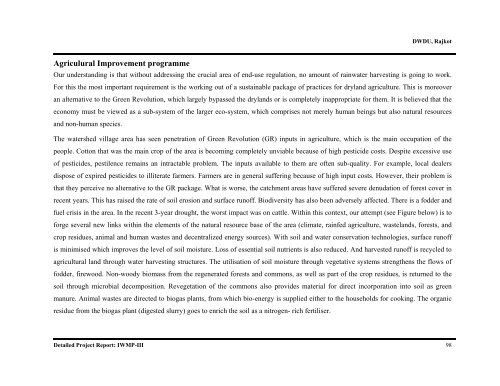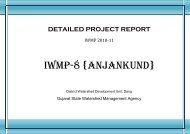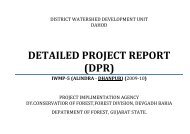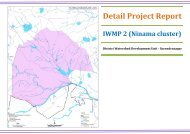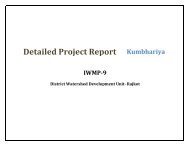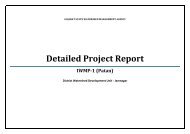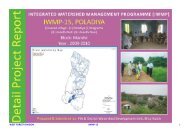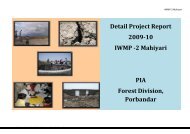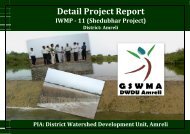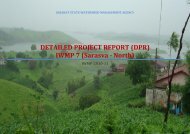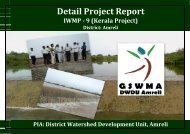IWMP-3 - Commissionerate of Rural Development Gujarat State ...
IWMP-3 - Commissionerate of Rural Development Gujarat State ...
IWMP-3 - Commissionerate of Rural Development Gujarat State ...
Create successful ePaper yourself
Turn your PDF publications into a flip-book with our unique Google optimized e-Paper software.
DWDU, Rajkot<br />
Agriculural Improvement programme<br />
Our understanding is that without addressing the crucial area <strong>of</strong> end-use regulation, no amount <strong>of</strong> rainwater harvesting is going to work.<br />
For this the most important requirement is the working out <strong>of</strong> a sustainable package <strong>of</strong> practices for dryland agriculture. This is moreover<br />
an alternative to the Green Revolution, which largely bypassed the drylands or is completely inappropriate for them. It is believed that the<br />
economy must be viewed as a sub-system <strong>of</strong> the larger eco-system, which comprises not merely human beings but also natural resources<br />
and non-human species.<br />
The watershed village area has seen penetration <strong>of</strong> Green Revolution (GR) inputs in agriculture, which is the main occupation <strong>of</strong> the<br />
people. Cotton that was the main crop <strong>of</strong> the area is becoming completely unviable because <strong>of</strong> high pesticide costs. Despite excessive use<br />
<strong>of</strong> pesticides, pestilence remains an intractable problem. The inputs available to them are <strong>of</strong>ten sub-quality. For example, local dealers<br />
dispose <strong>of</strong> expired pesticides to illiterate farmers. Farmers are in general suffering because <strong>of</strong> high input costs. However, their problem is<br />
that they perceive no alternative to the GR package. What is worse, the catchment areas have suffered severe denudation <strong>of</strong> forest cover in<br />
recent years. This has raised the rate <strong>of</strong> soil erosion and surface run<strong>of</strong>f. Biodiversity has also been adversely affected. There is a fodder and<br />
fuel crisis in the area. In the recent 3-year drought, the worst impact was on cattle. Within this context, our attempt (see Figure below) is to<br />
forge several new links within the elements <strong>of</strong> the natural resource base <strong>of</strong> the area (climate, rainfed agriculture, wastelands, forests, and<br />
crop residues, animal and human wastes and decentralized energy sources). With soil and water conservation technologies, surface run<strong>of</strong>f<br />
is minimised which improves the level <strong>of</strong> soil moisture. Loss <strong>of</strong> essential soil nutrients is also reduced. And harvested run<strong>of</strong>f is recycled to<br />
agricultural land through water harvesting structures. The utilisation <strong>of</strong> soil moisture through vegetative systems strengthens the flows <strong>of</strong><br />
fodder, firewood. Non-woody biomass from the regenerated forests and commons, as well as part <strong>of</strong> the crop residues, is returned to the<br />
soil through microbial decomposition. Revegetation <strong>of</strong> the commons also provides material for direct incorporation into soil as green<br />
manure. Animal wastes are directed to biogas plants, from which bio-energy is supplied either to the households for cooking. The organic<br />
residue from the biogas plant (digested slurry) goes to enrich the soil as a nitrogen- rich fertiliser.<br />
Detailed Project Report: <strong>IWMP</strong>-III 98


